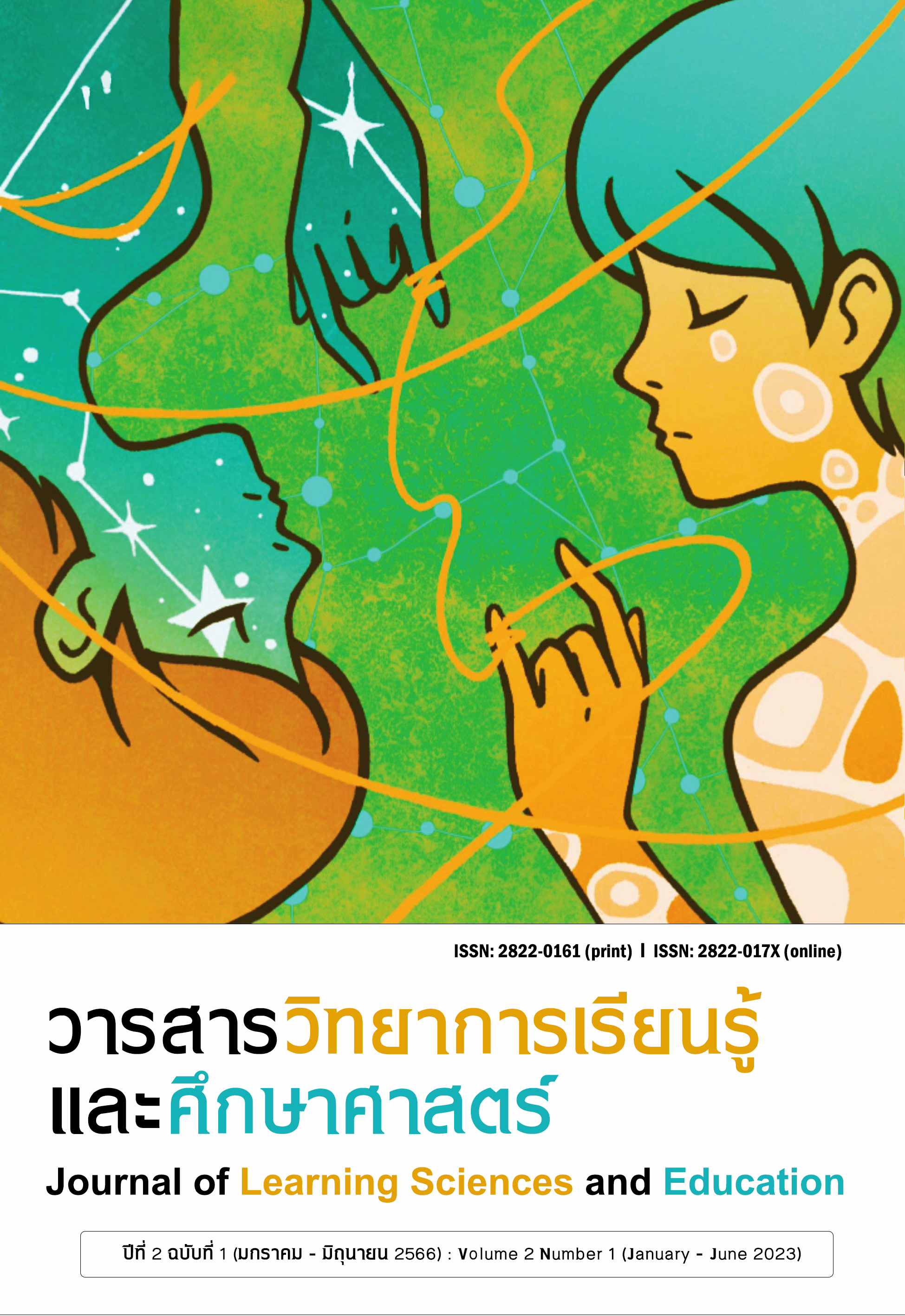นิเวศการเรียนรู้: พื้นที่และกระบวนการที่การเรียนรู้ดำรงอยู่
Main Article Content
บทคัดย่อ
แนวคิดเรื่องระบบนิเวศถูกนำมาใช้ในการอธิบายนอกสาขาชีววิทยาในหลายกรณี ทั้งนี้หัวใจสำคัญของมุมมองแบบนิเวศคือการมองแบบองค์รวม และเป็นมุมมองเชิงระบบ ที่มีหน่วยย่อยต่าง ๆ มีปฏิสัมพันธ์กัน เมื่อนำเรามุมมองแบบนิเวศมาใช้ในการมองการเรียนรู้นั้น เราจะเห็นถึงพื้นที่การเรียนรู้ ทรัพยากรการเรียนรู้ รวมถึงหน่วยต่าง ๆ เช่น ตำรา สื่อการสอน หรือผู้คน ในระบบปฏิสัมพันธ์กันทำให้เกิดการเรียนรู้ของคนในระบบ บทความนี้จะให้ภาพกว้างของแนวคิดนิเวศการเรียนรู้ รวมถึงแสดงถึงความจำเป็นในการปรับมุมมองจากมุมมองแบบดั้งเดิมมาเป็นมุมมองเชิงนิเวศ
Article Details

อนุญาตภายใต้เงื่อนไข Creative Commons Attribution-NonCommercial-NoDerivatives 4.0 International License.
เอกสารอ้างอิง
Aleisa, N. A. A. (2022). Graduate student’s use of social media as a learning space. Cogent Education, 9(1), 2010486. https://doi.org/10.1080/2331186X.2021.2010486
Baber, H. (2022). Social interaction and effectiveness of the online learning – A moderating role of maintaining social distance during the pandemic COVID-19. Asian Education and Development Studies, 11(1), 159-171. https://doi.org/10.1108/AEDS-09-2020-0209
Barron, B. (2006). Interest and Self-Sustained Learning as Catalysts of Development: A Learning Ecology Perspective. Human Development, 49(4), 193-224. https://doi.org/10.1159/000094368
Bronfenbrenner, U., & Morris, P. A. (2006). The Bioecological Model of Human Development
. In R. M. Lerner & W. Damon (Eds.), Handbook of child psychology: Theoretical models of human development (pp. 793–828). John Wiley & Sons, Inc.. https://www.childhelp.org/wp-content/uploads/2015/07/Bronfenbrenner-U.-and-P.-Morris-2006-The-Bioecological-Model-of-Human-Development.pdf
Cairns, L., & Stephenson, J. (2009). Capable workplace learning. Sense Publishers.
Desimone, L. M. (2009). Improving Impact Studies of Teachers’ Professional Development: Toward Better Conceptualizations and Measures. Educational Researcher, 38(3), 181-199. https://doi.org/10.3102/0013189X08331140
Epstein, J. L. (1987). Parent Involvement:What Research Says to Administrators. Education and Urban Society, 19(2), 119-136. https://doi.org/10.1177/0013124587019002002
Erragcha, N., Babay, H., Bchir, S., & Saidi, S. (2022). Impact of the Covid-19 pandemic on perceptions and behaviors of university students in Tunisia. E-Learning and Digital Media, 19(5), 456-474. https://doi.org/10.1177/20427530221108462
Freeze, R. D., & Kulkarni, U. (2007). Knowledge management capability: defining knowledge assets. Journal of Knowledge Management, 11(6), 94-109. https://doi.org/10.1108/13673270710832190
Guerra-Tamez, C. R. (2023). The Impact of Immersion through Virtual Reality in the Learning Experiences of Art and Design Students: The Mediating Effect of the Flow Experience. Education Sciences, 13(2), 185. https://www.mdpi.com/2227-7102/13/2/185
Inskru. (2023). Retrieved 8 May 2023 from https://new.inskru.com/
Jackson, N. (2016). Exploring Learning Ecologies. Chalk Mountain. http://www.normanjackson.co.uk/uploads/1/0/8/4/10842717/lulu_print_file.pdf
Jackson, N., & Barnett, R. (2020). Introduction: Steps to ecologies for learning and practice. In N. Jackson & R. Barnett (Eds.), Ecologies for learning and practice: Emerging ideas, sightings and possibilities (pp. 1-16). Routledge.
Joint Research, C., Institute for Prospective Technological, S., Kirschner, P., Gijsbers, G., Stoyanov, S., Punie, Y., Redecker, C., Leendertse, M., Hoogveld, B., & Leis, M. (2013). The future of learning : preparing for change. Publications Office. https://doi.org/doi/10.2791/64117
Joongpan, C. (2022). Type of learning facilitation and factors influencing learning facilitation at science museums in greater Bangkok. Journal of learning sciences and education, 1, 87-110. https://so07.tci-thaijo.org/index.php/JLSEd/issue/view/jlsed2022-1/jlsed2022-1
Kariippanon, K. E., Cliff, D. P., Lancaster, S. J., Okely, A. D., & Parrish, A.-M. (2019). Flexible learning spaces facilitate interaction, collaboration and behavioural engagement in secondary school. PLOS ONE, 14(10), e0223607. https://doi.org/10.1371/journal.pone.0223607
Kolb, A. Y., & Kolb, D. A. (2005). Learning Styles and Learning Spaces: Enhancing Experiential Learning in Higher Education. Academy of Management Learning & Education, 4, 193-212. https://doi.org/10.5465/AMLE.2005.17268566
Kongrod, K. (2023). Learning ecosystem of dream world: interaction and expectation of teacher affecting ecosystem of students’ development. In K. Kongtuk (Ed.), นิเวศการเรียนรู้กับการพัฒนาสมรรถนะ (pp. 187-228). Faculty of learning sciences and education, Thammasat University.
Kyndt, E., Gijbels, D., Grosemans, I., & Donche, V. (2016). Teachers’ Everyday Professional Development: Mapping Informal Learning Activities, Antecedents, and Learning Outcomes. Review of Educational Research, 86(4), 1111-1150. https://doi.org/10.3102/0034654315627864
Luckin, R. (2008). The learner centric ecology of resources: A framework for using technology to scaffold learning. Computers & Education, 50(2), 449-462. https://doi.org/https://doi.org/10.1016/j.compedu.2007.09.018
Marrow, A. J. (1977). The practical theorist : the life and work of Kurt Lewin. Teachers College Press.
Nguyen, L. T., & Tuamsuk, K. (2022). Digital learning ecosystem at educational institutions: A content analysis of scholarly discourse. Cogent Education, 9(1), 2111033. https://doi.org/10.1080/2331186X.2022.2111033
Nootpong, W. (2018). ''Land and air of growth'' the characteristics and the contexts of students with growth mindset: a multiple case study of middle school students in small extended educational opportunity schools under the Bangkok Metropolitan Administration [Master’s Thesis, Thammasat University]. Thammasat University Theses. Bangkok. https://doi.org/10.14457/TU.the.2018.7
Okita, S. Y. (2012). Social Interactions and Learning. In N. M. Seel (Ed.), Encyclopedia of the Sciences of Learning (pp. 3104-3107). Springer US. https://doi.org/10.1007/978-1-4419-1428-6_1770
Olson, M. H., & Hergenhahn, B. R. (2013). An introduction to theories of learning (9th ed.). Pearson Prentice Hall,.
Ostroumov, S. A. (2002). New definitions of the concepts and terms ecosystem and biogeocenosis. Doklady Biological Sciences, 383(1/6), 141-143. https://doi.org/10.1023/a:1015393924967
Pickett, S. T. A., & Cadenasso, M. L. (2002). The Ecosystem as a Multidimensional Concept: Meaning, Model, and Metaphor. Ecosystems, 5(1), 1-10. https://doi.org/10.1007/s10021-001-0051-y
Pinitwetchakarn, S. (2018). Study of student with reading difficulty: a case study of upper primary school student [Master’s Thesis, Thammasat University]. https://doi.org/10.14457/TU.the.2018.707
Reiser, B. J., & Tabak, I. (2014). Scaffolding. In R. K. Sawyer (Ed.), The Cambridge Handbook of the Learning Sciences (2 ed., pp. 44-62). Cambridge University Press. https://doi.org/DOI: 10.1017/CBO9781139519526.005
Sangrá, A., Raffaghelli, J. E., & Guitert‐Catasús, M. (2019). Learning ecologies through a lens: Ontological, methodological and applicative issues. A systematic review of the literature. British Journal of Educational Technology, 50(4), 1619-1638. https://doi.org/10.1111/bjet.12795
Sawyer, K. (2015). A Call to Action: The Challenges of Creative Teaching and Learning. Teachers College Record, 117(10), 1-34. https://doi.org/10.1177/016146811511701001
Siemens, G. (2007). Connectivism: Creating a learning ecology in distributed environments. In T. Hug (Ed.), Didactics of Microlearning: Concepts, Discourses and Examples (pp. 53-68). Waxmann.
Steinberg, L., Darling, N. E., & Fletcher, A. C. (1995). Authoritative parenting and adolescent adjustment: An ecological journey. In Examining lives in context: Perspectives on the ecology of human development. (pp. 423-466). American Psychological Association. https://doi.org/10.1037/10176-012
Suteethorn, V., & Kavinate, S. (2022). Sirindhorn Museum: the space for learning about fossils. Journal of learning sciences and education, 1, 27-58. https://so07.tci-thaijo.org/index.php/JLSEd/issue/view/jlsed2022-1/jlsed2022-1
Xie, Y., Huang, Y., Luo, W., Bai, Y., Qiu, Y., & Ouyang, Z. (2023). Design and effects of the teacher-student interaction model in the online learning spaces. Journal of Computing in Higher Education, 35(1), 69-90. https://doi.org/10.1007/s12528-022-09348-9


